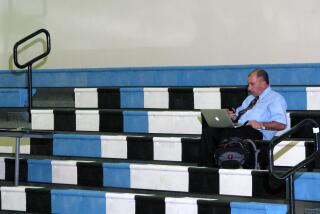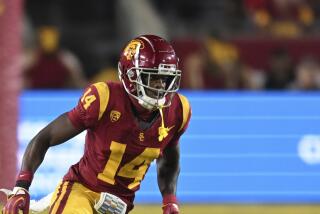Shackleford Keeps Moving On by Moving His Athletes Along : Football: Golden West coach takes great pride in helping his players continue their careers at four-year colleges.
- Share via
HUNTINGTON BEACH — Early each morning, when Ray Shackleford walks into his office at Golden West College, he stares directly at the reason he works.
There are trophies and awards, but the Rustlers’ football coach instead is motivated by one wall covered with photographs and another with lists of past players who have continued their careers at four-year colleges.
In all, more than 275 players have been sent on to four-year schools by Shackleford, who is entering his 25th season at Golden West. Shackleford, 52, is the only head coach the Rustlers have had.
Golden West has had its share of outstanding players, including Blaise Bryant, who is the starting tailback at Iowa State.
Glenn Parker, a mammoth lineman who was an all-Pacific 10 offensive tackle for Arizona last season, also played at Golden West. Parker will be the starting left tackle for the Buffalo Bills this season.
Wide receiver Randy Vataha, who went on to star at Stanford and then played for the New England Patriots, was also a Rustler.
But as Shackleford is quick to point out, those kinds of players aren’t overlooked by college recruiters.
Shackleford takes great pride in placing players who are more difficult to sell. From last year’s 5-5 team, 20 players went on to four-year schools.
“Media-wise it’s no contest that Blaise (Bryant) and (Glenn) Parker have gotten the most attention of our former players,” Shackleford said. “And that’s exciting for them and for us. It really shows what this level can do.
“But the guys we work hard for are the ones you have to place. That’s always been our goal from the start, and should always be the goal of this level.”
The start for Shackleford was in December, 1965, when Golden West was about to open. He was then an assistant coach at Arizona, where he played as a quarterback and defensive back in 1959-60, after attending Compton College and Paramount High School.
Shackleford was in Southern California on a recruiting trip for Arizona when he heard about the Golden West position. At 26, he applied and was selected.
“He did something at 26 that I’m not sure I’m ready to do at 38,” said assistant Mike Shaughnessy, who played at Golden West in 1970-71. “He decided a long time ago that he wasn’t going to just coach for a few years. He was going for the long haul. That is how he has approached his job.”
Golden West was 5-3-1 in its first season, and Shackleford’s career record is 136-92-9. His teams have had only six losing seasons and have never finished more than two games below .500.
“It was never my intention at all to stay this long,” Shackleford said. “I had a few chances to leave in the first years to become an assistant, but this is what I wanted to do as it turned out. . . . It’s a good job and as long as we keep getting good players and stay competitive, I will stay at it.”
Golden West’s best seasons came in 1977 and ‘78, when the team went 9-2 each year. Shackleford’s typical team runs more than passes and features giant offensive linemen.
“What Ray has done is amazing if you consider two things,” said defensive coordinator Don Rowe, who was part of Shackleford’s first staff. “He makes the kids work and be responsible in the classroom. Not all of them like that, but he demands it. Also, he doesn’t duck anybody on the schedule. If you want a good record, you could play your grandmother, but Ray won’t do that.”
Shackleford is also dedicated to remaining physically fit. He arrives at school by 6:15 every morning and works out in the fitness room for nearly an hour. Though his days are long, he tries to make sure he and his staff are home for dinner each night.
Shackleford agrees that he has mellowed some over the years, but his sideline outbursts are often loud enough to reach the top of the bleachers, and practice sessions at Golden West are still not an easy way to spend an afternoon.
“We try and impress upon the players that good work habits in practice are important,” he said. “That’s where we get most of our work done. . . . Some guys make great speeches before games. I don’t. Our whole emphasis is our work ethic in practice. This is where we get the effort and motivation that are needed for the game.”
Bryant and Parker are examples of work ethic paying off.
Bryant came to Golden West after being declared academically ineligible at Hawaii. After earning his Associate of Arts degree in three semesters at Golden West, he transferred to Iowa State in 1989 and became a starter.
Parker, despite being 6 feet 5 and close to 300 pounds, didn’t play football at Edison High School and attended Golden West for a year before coming out for the team.
“I was impressed that Ray was able to get him (Parker) out for football at all,” said Bill Workman, former Edison Coach now at Orange Coast College. “We tried, but he was pretty soft at the time.”
Shackleford and his staff talked with Parker a few times, finally convincing him to give it a try. After his first season, Parker was told by linebacker coach Dennis Dixon that if he continued to work hard, he could earn a scholarship to any college in the country.
Parker continued to improve and went to Arizona on scholarship, turning down offers from USC and Tennessee.
“I owe it all to the coaches at Golden West,” Parker said earlier this year. “They taught me the importance of a good work ethic, and what can come from it.”
More to Read
Go beyond the scoreboard
Get the latest on L.A.'s teams in the daily Sports Report newsletter.
You may occasionally receive promotional content from the Los Angeles Times.










